Top speed 558 km/h Introduced 1949 Weight 36,850 kg | Range 5,400 km Wingspan 43 m Length 30 m | |
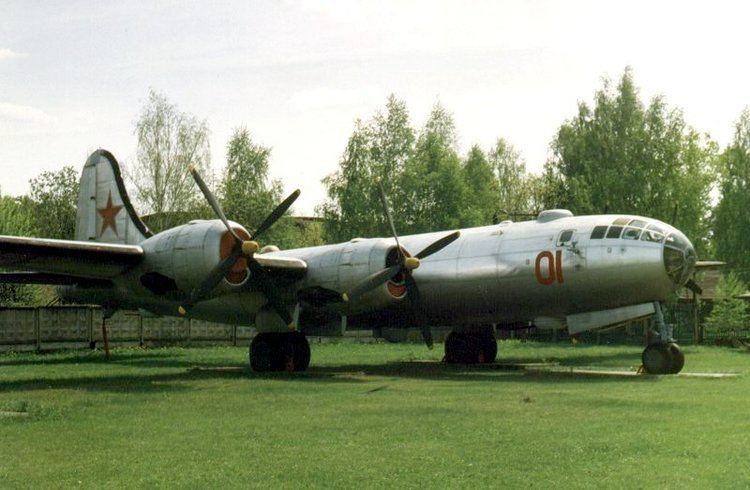 | ||
Tupolev tu 4 nato code bull
The Tupolev Tu-4 (NATO reporting name: Bull) was a piston-engined Soviet strategic bomber that served the Soviet Air Force from the late 1940s to mid-1960s. It was a reverse-engineered copy of the American-made Boeing B-29 Superfortress.
Contents
- Tupolev tu 4 nato code bull
- Tupolev tu 4 long range bomber documentary made in the ussr
- Design and development
- First public appearance
- Operational history
- Variants
- Operators
- Survivors
- Specifications Tu 4
- References
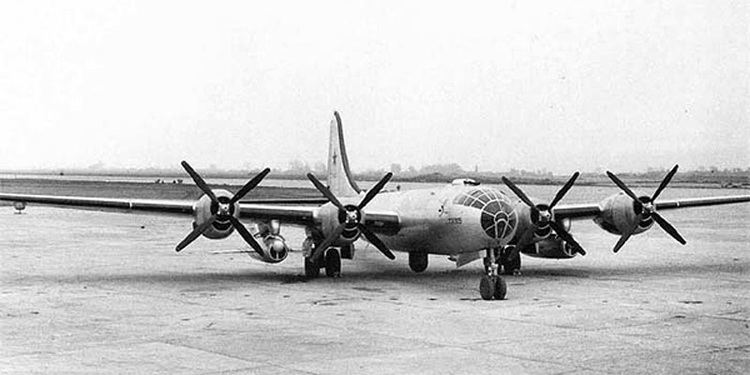
Tupolev tu 4 long range bomber documentary made in the ussr
Design and development
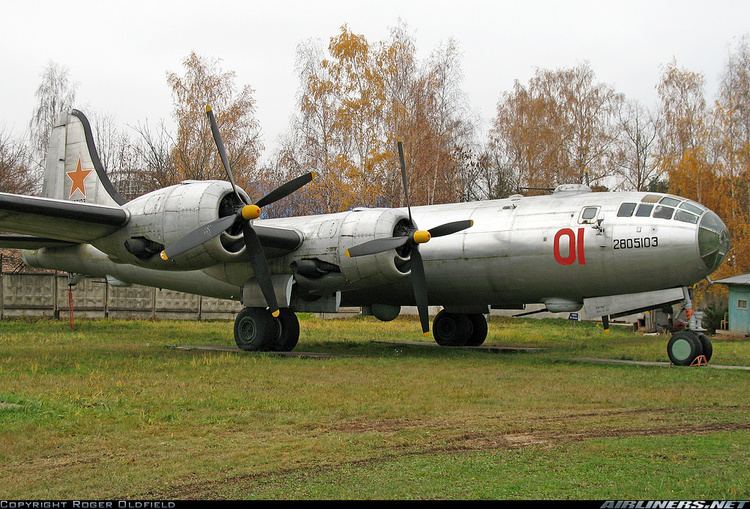
Toward the end of World War II, the Soviet Union saw the need for a strategic bombing capability similar to that of the United States Army Air Forces. The Soviet VVS air arm had the locally designed Petlyakov Pe-8 four-engined "heavy" in service at the start of the war, but only 93 had been built by the end of the war and the type had become obsolete. The U.S. regularly conducted bombing raids on Japan, from distant Pacific forward bases using B-29 Superfortresses. Joseph Stalin ordered the development of a comparable bomber.
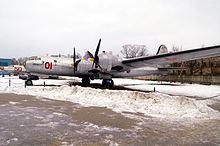
The U.S. twice refused to supply the Soviet Union with B-29s under Lend Lease. However, on four occasions during 1944, individual B-29s made emergency landings in Soviet territory and one crashed after the crew bailed out. In accordance with the Soviet–Japanese Neutrality Pact, the Soviets were neutral in the Pacific War and the bombers were therefore interned and kept by the Soviets. Despite Soviet neutrality, America demanded the return of the bombers, but the Soviets refused. Three repairable B-29s were flown to Moscow and delivered to the Tupolev OKB. One B-29 was dismantled, the second was used for flight tests and training, and the third one was left as a standard for cross-reference. The aircraft included one Boeing-Wichita −5-BW, two Boeing-Wichita −15-BWs and the wreckage of one Boeing-Renton −1-BN – three different models from two different production lines (respectively Wichita and Renton factories). Only one of the four had de-icing boots as used on the Tu-4. The fourth B-29 was returned to the US along with its crew with the end of the Russo-Japanese entente following the Soviet declaration of war against Japan two days after the atomic bombing of Hiroshima, in accordance with the Yalta agreement.
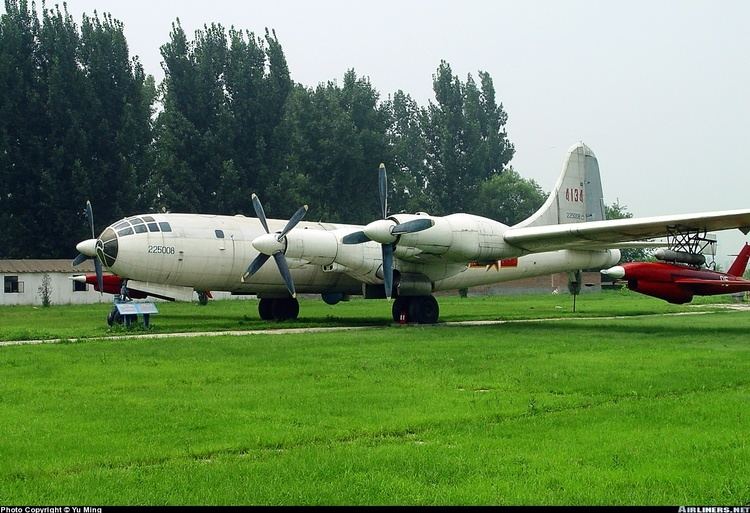
Stalin told Tupolev to clone the Superfortress in as short a time as possible instead of continuing with his own comparable ANT-64. The reverse-engineering effort involved 900 factories and research institutes, who finished the design work during the first year; 105,000 drawings were made. By the end of the second year, the Soviet industry was to produce 20 copies of the aircraft. ready for State acceptance trials.
The Soviet Union used the metric system, so sheet aluminium in thicknesses matching the B-29's imperial measurements were unavailable. The corresponding metric-gauge metal was of different thicknesses. Alloys and other materials new to the Soviet Union had to be brought into production. Extensive re-engineering had to take place to compensate for the differences, and Soviet official strength margins had to be decreased to avoid further redesign, yet despite these challenges the prototype Tu-4 weighed only about 340 kg (750 lb) more than the B-29, a difference of less than 1%.
The engineers and suppliers of components were under pressure from Tupolev, Stalin, and the government to create an exact clone of the original B-29 to facilitate production and Tupolev had to overcome substantial resistance in favor of using equipment that was not only already in production but in some cases better than the American version. Each component made and each alteration was scrutinized and was subject to a lengthy bureaucratic process. Differences were limited to the engines, the defensive weapons, the radio (a later model used in lend-lease B-25s was used in place of the radio in the interned B-29s) and the identification friend or foe (IFF) system – the American IFF being unsuitable. The Soviet Shvetsov ASh-73 engine was a development of the Wright R-1820 but was not otherwise related to the B-29's Wright R-3350 The ASh-73 also powered some of Aeroflot's remaining obsolescent Petlyakov Pe-8 airframes, a much earlier Soviet four-engined heavy bomber whose production was curtailed by higher priority programs. The B-29's remote-controlled gun turrets were redesigned to accommodate the harder hitting and longer ranged Soviet Nudelman NS-23 23mm cannon. Kerber, Tupolev's deputy at the time, recalled in his memoirs that engineers needed authorization from a high-ranking general to use Soviet-made parachutes. Additional changes were made as a result of problems encountered during testing, related to engine and propeller failures and equipment changes were made throughout the aircraft's service life.
The Tu-4 first flew on 19 May 1947, piloted by test pilot Nikolai Rybko. Serial production started immediately, and the type entered large-scale service in 1949. Entry into service of the Tu-4 threw the USAF into a panic, since the Tu-4 possessed sufficient range to attack Chicago or Los Angeles on a one-way mission, and this may have informed the maneuvers and air combat practice conducted by US and British air forces in 1948 involving fleets of B-29s. Some attempts to develop midair refueling systems were made to extend the bomber's range, but these were fitted to only a few aircraft.
First public appearance
The aircraft was first displayed during a flyover at the Aviation Day parade on 3 August 1947 at the Tushino Airport in Moscow. Three aircraft flew overhead. It was assumed that these were merely the three B-29 bombers that were known to have been diverted to the USSR during World War II. Minutes later a fourth aircraft appeared. Western analysts realized that the Soviets must have reverse-engineered the B-29. The appearance of an obviously Superfortress-derived Tu-70 transport over the crowd removed any doubt about the success of the reverse-engineering.
Operational history
A total of 847 Tu-4s had been built when production ended in the Soviet Union in 1952, some going to China during the later 1950s. Many experimental variants were built and the valuable experience launched the Soviet strategic bomber program. Tu-4s were withdrawn in the 1960s, being replaced by more advanced aircraft including the Tupolev Tu-16 jet bomber (starting in 1954) and the Tupolev Tu-95 turboprop bomber (starting in 1956). By the beginning of the 1960s, the only Tu-4s still operated by the Soviets were used for transport or airborne laboratory purposes. A Tu-4A was the first Soviet aircraft to drop a nuclear weapon, the RDS-1.
Variants
Operators
The Soviet Air Force operated 847 Tupolev Tu-4 bombers between 1948 and early 1960. They were initially used as long-range bombers. In 1954 the Soviets began phasing out the Tu-4; units upgraded to Tupolev Tu-16 bombers and, beginning in 1956, to Tupolev Tu-95 bombers. Tu-4s withdrawn from front line units were used for transport duties.
On 28 February 1953, Joseph Stalin gave China ten Tu-4 heavy bombers. These Tu-4's were refitted with AI-20K turboprop engines in 1966. The last PLAAF Tu-4 were retired in 1988.
In 1967 China attempted to develop its first airborne early warning aircraft, based on the Tu-4 airframe. The project was named KJ-1 and mounted a Type 843 rotodome on top of the aircraft. However, the radar and equipment was too heavy, and the KJ-1 did not meet PLAAF's requirements. The project was canceled in 1971. The single prototype aircraft is now on display at the PLAAF museum north of Beijing.
Survivors
Specifications (Tu-4)
Data from Tupolev Tu-4 Soviet Superfortress
General characteristics
Performance
Armament
or
